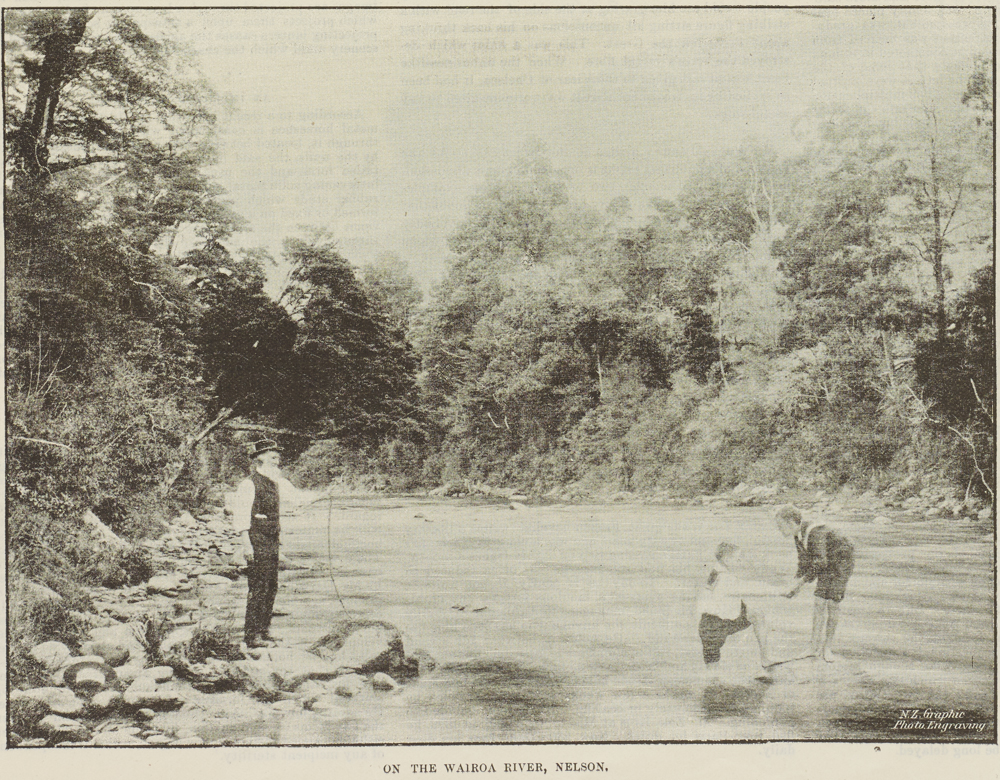Brightwater Tuna
The Waimeha or Waimea Plains, including Brightwater, were historically significant for Māori as a key trading route and a rich food-gathering area, with large kūmara gardens, abundant birdlife, and eel harvesting in the Wairoa River. European settlers, however, saw eels as a threat to the newly introduced brown trout.
Waimeha Heritage
Brightwater is part of the Waimea/Waimeha Plains and is along the traditional trading route for Māori between Whakatū (Nelson) and Te Tai Poutini (The West Coast). A number of pā or Kāinga (forts or settlements) were once located on the Waimeha plains, including a small satellite pā located near where Snowden’s Bush is today.1
With its abundance of natural resources, the Waimeha was an important food-gathering and harvesting site for local Iwi whānau. They cultivated large kūmara gardens (over 400 hectares), birds provided meat and feathers, pakohe (argillite or metamorphosed indurated mudstone) was quarried from the Wairoa River for tools or traded with Iwi across Te Tau Ihu and Harakeke (flax) was plentiful.2,3
The Wairoa River was a significant eel (tuna or Kuwharuwharu) harvesting site. Tuna, inanga (whitebait) and other freshwater fish were plentiful with seasonal migrations providing food at different times of the year.
Tuna was both nutritionally and culturally important for Iwi. Fishing brought extended families together to work and share in the bounty of the catch, and many traditional songs, stories, and cultural practices developed around the tuna.4
However, tuna wasn’t so popular with the early European settlers in the area. In the late 1860s the Nelson Acclimatisation Society introduced brown trout to local rivers. Acclimatisation societies imported traditional English animals and plants to New Zealand and then sold licences to hunt and fish the animals they imported.5
Of course, local tuna didn’t know they needed a licence and set about devouring the trout. One large female as known as the “Brightwater Poacher” and evaded capture for some time. When she was finally caught, she weighed 23lb (just over 10 kg), was 4ft 6in length (about 1.4 metres), and girth 1ft 4in. (almost 50 cm).6
The Society offered bounties of up to one shilling per pound for eels of l0lbs (4.5kg) or over caught in Waimea County rivers in order to protect their trout. Today Tuna is a delicacy and very much sought after by Iwi and the local community.7
Brightwater Heritage Boards 2020
Updated, March 25, 2025
Story by: Tasman Libraries
Brightwater Māori Brightwater Heritage Boards Acclimatisation Society Wairoa River
Sources
- Tasman District Council. (2006). Cultural impact assessment of the Lee and Wairoa. Tasman District Council. p.33.
- Mitchell, J; Mitchell, H. (2004). Te Tau Ihu O Te Waka, A History of Maori or Nelson and Marlborough. Volume I, Te Tangata me te Whenua: The People and the Land. Huia Publishers.
http://www.worldcat.org/oclc/63170610 - Mitchell, J. and H. (2008).Pakohe - Argillite.The Prow.
https://www.theprow.org.nz/maori/pakohe-argillite/ - Te Tau Ihu Mahi Tuna (TTI) (Nelson/North Marlborough) Eel Management Committee (EMC 6). Eel management area plan. p.7.
- Walrond, C. (2008, Nov 1). ‘Acclimatisation - Improving upon nature', Te Ara - the Encyclopedia of New Zealand.
http://www.TeAra.govt.nz/en/acclimatisation/page-1 - Weekly whispers. (1901 September 23). Nelson Evening Mail. p.2.
https://paperspast.natlib.govt.nz/newspapers/NEM19010923.2.8 and
Brightwater. (1901, October 15). Colonist. p.1.
https://paperspast.natlib.govt.nz/newspapers/TC19011015.2.23.7 - Nelson Acclimatization Society. (12 December 1903). Colonist. p.3.
https://paperspast.natlib.govt.nz/newspapers/TC19031212.2.16.5
Further Sources
Books
- Best, E. (1929). Fishing Methods and Devices of the Māori. Dominion Museum Bulletin No. 12. E. C. Keating, Government Printer
https://www.worldcat.org/oclc/601923282 - Fuller, D. (1978). Māori food and cookery. A. H. & A. W. Reed Ltd.
https://www.worldcat.org/oclc/5661776 - Mitchell, J; Mitchell, H. (2004). Te Tau Ihu O Te Waka, A History of Māori or Nelson and Marlborough. Volume I, Te Tangata me te Whenua: The People and the Land. Huia Publishers.
https://www.worldcat.org/oclc/63170610
Newspapers
- Babirat, C., Torckler, D. (2010, Sep-Oct). Taniwha. NZ Geographic 105.
https://www.nzgeo.com/stories/taniwha/ - Hansford, D. (2012, Mar-Apr). Hunting utopia. NZ Geographic, 114.
https://www.nzgeo.com/stories/hunting-utopia/
Websites
- Integrated Catchment Management. (n.d.). Māori history and values – Motueka.
https://icm.landcareresearch.co.nz/research/human_dimensions/maori_history.asp#taonga - Fisheries New Zealand. (n.d.). Freshwater eels Nelson/Marlborough (ANG11).
https://fs.fish.govt.nz/Page.aspx?pk=8&stock=ANG11 - Keane, B. 'Te hopu tuna – eeling - Origins and types of tuna – eels', Te Ara - the Encyclopedia of New Zealand.
http://www.TeAra.govt.nz/en/te-hopu-tuna-eeling/page-1 - Mitchell H., & Mitchell. J. (2017). 'Te Tau Ihu tribes', Te Ara - the Encyclopedia of New Zealand.
http://www.TeAra.govt.nz/en/te-tau-ihu-tribes - Tasman District Council. (2010, August). Waimea River Park Management Plan.
https://www.tasman.govt.nz/my-council/projects/waimea-river-park-development/ - Walls, G. Y. (1981, Feb 20). Botanical/ecological notes on Snowdens Bush, Brightwater, Nelson. Report (New Zealand. Botany Division): 352. Botany Division, Department of Scientific and Industrial Research.
http://doi.org/10.7931/DL1-VR-352
